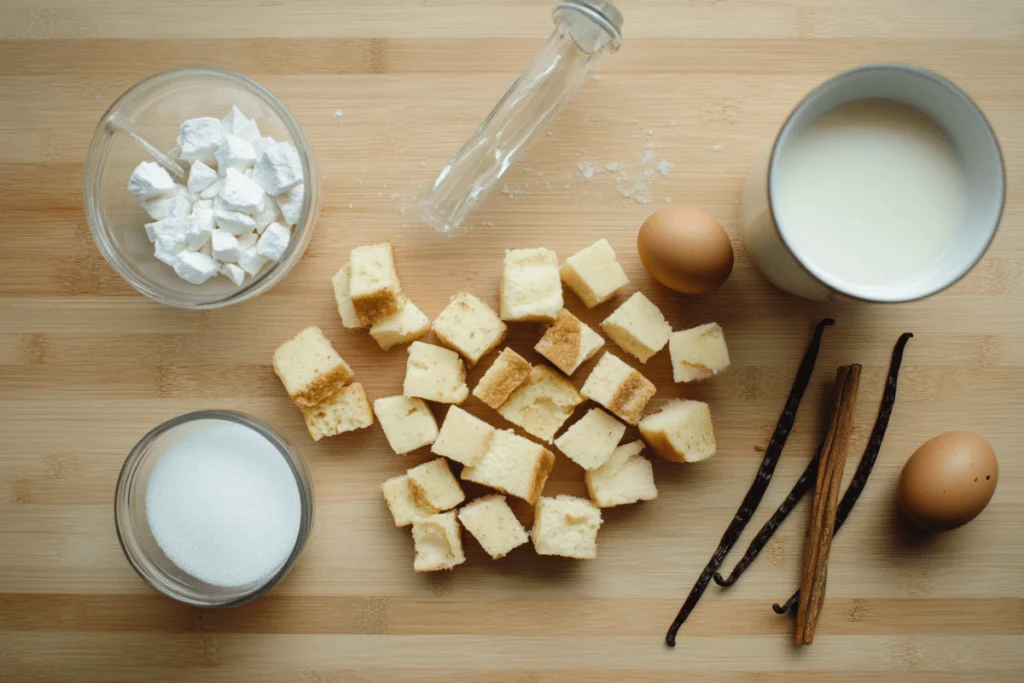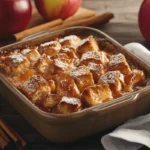If there’s one dessert that’s both cozy and effortlessly classy, it’s bread pudding—and when you make it with sourdough bread, oh boy, you’re in for a treat. Imagine golden, slightly tangy bread chunks soaked in creamy custard, baked to perfection, and topped with a luscious sauce. Whether you’re a dessert enthusiast, a sourdough bread lover, or someone just looking for a creative way to use up day-old bread, this guide is for you.
In this post, I’ll walk you through everything: the history of bread pudding, why sourdough makes it extra special, a step-by-step classic recipe, creative variations, serving tips, health insights, and answers to the most common FAQs. So, preheat your oven and let’s turn those sourdough slices into something magical! 🍞✨
Table of contents
What is Sourdough Bread Pudding?
The Origins of Bread Pudding
Bread pudding has humble beginnings. Born out of the need to prevent food waste, it started as a way to use stale bread by soaking it in milk, sugar, and eggs before baking. This dessert can be traced back to medieval Europe, where resourceful cooks repurposed old bread into hearty puddings.
Over time, it crossed continents and evolved with cultural influences. In England, it was called “poor man’s pudding.” In New Orleans, it became a Southern classic, often topped with rich bourbon sauce. And today, it’s celebrated worldwide for its simplicity and comforting taste.
Why Sourdough Bread is a Game-Changer
So why use sourdough instead of regular bread? For starters:
- Tangy Flavor: The slight sourness of sourdough contrasts beautifully with the sweet custard.
- Texture: Sourdough has a sturdy, chewy crumb that soaks up custard without turning into mush.
- Nutritional Value: Naturally fermented, sourdough offers probiotics and is easier to digest compared to regular bread.
Fun Fact: The natural acidity in sourdough bread also helps balance the sweetness of traditional bread pudding.
If you’re curious about other creative bread pudding variations, you might love the Applesauce Bread Pudding Recipe—a fruity twist on this timeless favorite.
Key Characteristics of Sourdough Bread Pudding
- Flavor: Tangy bread balances sweet custard.
- Texture: Firm but soft, with golden crispy edges.
- Versatility: Pairs wonderfully with add-ins like fruits, nuts, or chocolate.
- Visual Appeal: Rustic and hearty, sourdough bread pudding always looks inviting on the plate.
Whether you’re making it for a holiday gathering or just a quiet weekend treat, sourdough bread pudding is bound to impress.
Essential Ingredients for Sourdough Bread Pudding
The Must-Have Ingredients
A great sourdough bread pudding starts with quality ingredients. Here’s what you’ll need:

- Sourdough Bread: Day-old or slightly stale works best.
- Eggs: These create the custardy base.
- Milk or Cream: Whole milk or heavy cream adds richness.
- Sugar: White or brown sugar sweetens the custard.
- Vanilla Extract: Adds warmth and aroma.
- Spices: Cinnamon, nutmeg, and even a pinch of cardamom work beautifully.
- Butter: Adds moisture and a golden finish.
Choosing the Right Sourdough Bread
Not all sourdough loaves are created equal. Choose one with:
- A crusty exterior (it holds up well when soaked).
- An airy, open crumb that absorbs custard easily.
- A neutral flavor (avoid loaves with strong flavors like garlic or rosemary unless you’re going savory).
Pro Tip: Fresh sourdough can still work if you toast the cubes lightly before soaking.
Optional Add-Ins for Extra Flavor
- Fruits: Raisins, dried cranberries, or fresh berries.
- Nuts: Chopped pecans, walnuts, or almonds.
- Chocolate Chips: For a rich, gooey twist.
- Liquor: A splash of bourbon or rum in the custard mixture takes it to another level.
Why These Ingredients Work Together
The magic of bread pudding lies in balance. The eggs and milk create a creamy base, while the sourdough bread absorbs the mixture without falling apart. Spices like cinnamon and nutmeg add warmth, while vanilla ties everything together.
Classic Sourdough Bread Pudding Recipe
Ingredients:
- 6 cups cubed sourdough bread (day-old)
- 4 large eggs
- 2 cups whole milk
- 1 cup heavy cream
- ¾ cup granulated sugar
- 2 tsp vanilla extract
- 1 tsp cinnamon
- ½ tsp nutmeg
- ½ cup melted butter
- Optional: ½ cup raisins or chocolate chips
Step-by-Step Instructions:
Step 1: Prep the Bread
Cube the sourdough bread into bite-sized pieces and place them in a large mixing bowl.
Step 2: Prepare the Custard
In a separate bowl, whisk together eggs, milk, cream, sugar, vanilla, cinnamon, and nutmeg until smooth.
Step 3: Combine
Pour the custard mixture over the bread cubes, ensuring every piece is soaked. Let it sit for 20–30 minutes to absorb fully.
Step 4: Bake
Preheat your oven to 350°F (175°C). Transfer the soaked bread mixture into a greased baking dish. Drizzle melted butter evenly on top.
Step 5: Cook
Bake for 45–50 minutes, or until the custard is set and the top is golden brown.
Step 6: Cool and Serve
Allow the pudding to cool slightly before serving.

Serving Suggestions:
- Top with caramel or vanilla sauce.
- Add a scoop of vanilla ice cream or a dollop of whipped cream.
Pro Tip: Bread pudding tastes best warm but can also be enjoyed cold.

Variations of Sourdough Bread Pudding
1. Vegan Sourdough Bread Pudding
- Replace eggs with flaxseed meal (1 tbsp flaxseed + 3 tbsp water per egg).
- Use almond or oat milk instead of dairy.
- Substitute butter with coconut oil.
2. Chocolate Sourdough Bread Pudding
- Add 1 cup of chocolate chips.
- Drizzle with chocolate sauce before serving.
3. Fruity Sourdough Bread Pudding
- Mix in raisins, diced apples, or fresh berries.
- Add a sprinkle of cinnamon sugar on top before baking.
4. Savory Sourdough Bread Pudding
- Skip sugar and vanilla.
- Add sautéed onions, spinach, and shredded cheese.
- Serve as a side dish with roasted meats.
5. Gluten-Free Version
Use gluten-free sourdough bread and ensure all other ingredients are certified gluten-free.
Topping and Sauce Ideas
Classic Toppings:
- Whipped cream
- Fresh berries
- Powdered sugar
Best Sauce Pairings:
- Caramel Sauce: Sweet and buttery.
- Vanilla Sauce: Smooth and creamy.
- Bourbon Sauce: Bold and flavorful.
Creative Toppings:
- Crushed nuts
- Citrus zest
- Maple syrup
Pro Tip: Serve sauces warm for an extra indulgent experience.
Tips for Perfect Sourdough Bread Pudding
Creating the perfect sourdough bread pudding is all about balancing texture, flavor, and technique. Below is a quick-reference table with essential tips for each stage of the process.
📊 Key Tips for Perfect Sourdough Bread Pudding
| Step | Tip | Why It Matters |
|---|---|---|
| Choose Bread | Use day-old, crusty sourdough bread. Toast fresh bread lightly. | Prevents mushy texture and absorbs custard evenly. |
| Bread-to-Custard Ratio | Ensure bread is thoroughly soaked but not swimming in custard. | Balances creaminess and structure. |
| Soaking Time | Let bread soak for 20–30 minutes before baking. | Allows custard to fully penetrate bread pieces. |
| Custard Mixture | Use a mix of milk, cream, eggs, and spices (cinnamon, vanilla). | Creates a smooth, flavorful custard base. |
| Add-Ins | Add raisins, chocolate chips, or nuts for extra flavor. | Adds texture and enhances overall taste. |
| Baking Dish | Use a ceramic or glass dish for even baking. | Prevents uneven cooking and sticking. |
| Baking Time | Bake at 350°F (175°C) for 45–50 minutes. | Ensures custard sets without drying out. |
| Cover While Baking | Cover with foil for the first 20–25 minutes, then uncover. | Prevents drying out while allowing a golden top. |
| Resting Time | Let pudding rest for 10–15 minutes before serving. | Allows custard to set for easier slicing and serving. |
| Sauce | Serve warm with caramel, vanilla, or bourbon sauce. | Enhances flavor and adds a rich finishing touch. |
| Storage | Refrigerate for 3–4 days or freeze for up to 3 months. | Maintains freshness and prevents spoilage. |
| Reheat | Warm in the oven at 300°F or in the microwave in short bursts. | Restores texture without overcooking. |
🍮 Pro Tips for Extra Perfection
- Taste the Custard: Adjust sugar and spices before pouring over bread.
- Golden Top Trick: Brush the top with melted butter before baking.
- Creative Toppings: Add powdered sugar, fresh berries, or mint leaves for a finishing touch.
- Experiment: Try savory versions with cheese, herbs, or sautéed veggies.
Health and Nutritional Insights
| Aspect | Details |
|---|---|
| Calories | Approx. 300-400 per serving |
| Key Nutrients | Carbs, Protein, Calcium |
| Dietary Options | Vegan, Gluten-Free variations |
| Serving Size Tip | Moderation is key |
| Best Pairing | Fresh berries or low-sugar sauce |
FAQs About Sourdough Bread Pudding
Sourdough bread is considered healthier because of its fermentation process, which breaks down gluten and phytic acid, making it easier to digest. It also has a lower glycemic index, causing slower blood sugar spikes compared to regular bread. Plus, sourdough is often made with fewer additives and uses simple, natural ingredients. While it still contains calories, its nutrient density and ability to keep you feeling full make it a better choice when eaten in moderation.
If you have extra sourdough bread, get creative! Make bread pudding, French toast, or croutons for salads. Blend it into bread crumbs for coatings or toppings. Create a delicious bruschetta with tomatoes and olive oil, or use it in a savory stuffing for a holiday meal. To avoid waste, slice and freeze leftover sourdough for future use—it reheats beautifully.
Mushy bread pudding happens when there’s too much custard, not enough soaking time, or fresh bread instead of day-old bread. Always let the bread soak evenly and bake until the custard is set but slightly jiggly in the center. Don’t skip the resting period after baking—it helps the pudding firm up for perfect texture.
Never use fresh sourdough for bread pudding—it’ll turn mushy. Avoid storing it in plastic bags or refrigerating fresh sourdough, as it ruins the crust. Stick to day-old bread for recipes, and if you’re baking sourdough, don’t rush the fermentation process. Lastly, avoid using flavored sourdough (like garlic or herb) in sweet recipes.
Final Thoughts
Sourdough bread pudding is the perfect combination of comfort food nostalgia and gourmet flair. Whether you stick to the classic recipe, add fruits, or go for a savory twist, this dessert always hits the spot. So, grab your sourdough loaf, whip up some custard, and treat yourself to a dish that feels like a warm hug.
Happy baking! 🍞✨



